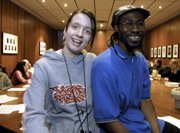
Symposium co-organizers Katherine Blenkinsop, alias Katalyst, and Diegal
Léger — both “proud students for the advancement of
hiphop culture.”
Photo by Andrew Dobrowolskyj
|
by Eyad Hamam
For four days last week, Concordia hosted a symposium about hiphop culture,
its role in society and the possibility of including “hiphop education”
in school and university systems in Canada.
Hiphop is an art form that includes deejaying, or “cutting and scratching,”
emceeing and rapping, breakdancing and graffiti art. These popular art
forms originated in the South Bronx section of New York City around the
mid-1970s, though they are often associated with older traditions, including
aboriginal drums and dancing.
In the view of some observers, hiphop helped curtail gang violence by
giving gang members an alternative method of competing and expressing
their aggression.
“The changes in the hiphop scene reflect the changes in a segment
of society, and you have to have some method to archive and keep track
of the changes,” said Diegal Léger, an independent graduate
student at the John Molson School of Business and one of the symposium’s
organizers.
Léger acted as moderator during four roundtable discussions that
brought together students and artists active in hiphop. The subjects included
the history of hiphop and its connection to oral tradition and drums,
hiphop as a tool for social change, women’s roles in hiphop culture;
and the workings of the hiphop industry.
Dispeling misconceptions
K8 (pronounced Kate) Asterlund, who graduated from Concordia with a degree
in English literature and contemporary dance, believes hiphop is an educational
tool in and of itself. However, there are many misconceptions about hiphop.
Contrary to popular belief, she said, “hiphop” doesn’t
only refer to the music: graffiti, bboying/bgirling (forerunners of break
dancing) and turntablism are all part of hiphop culture.
“There should be more education about what hiphop culture is all
about, and there should be more involvement from people within hiphop
culture.” She said this means schools as well as universities.
For Sonya Braich, a Concordia student in her final year of film studies,
hiphop should be part of the educational system. “It’s about
broadening the educational system to include the various cultural backgrounds
we come from, and that includes hiphop, native, aboriginal, and all the
many cultures in Canadian society,” she said.
“I know some teachers that actually took the initiative to talk to
their students and find out about their culture and know where they’re
coming from. That’s the learning environment that our children —
and each of us — should be raised in.”
As well as roundtable discussions, students from various disciplines gave
talks. On Friday, Annam Lê (a.k.a. DJ Mana), a communications/psychology
student at Concordia, gave a talk on turntable methodology.
Louis Dufieux, a second-year student enrolled in the graduate diploma
in translation, talked about how hiphop can cross language boundaries.
He emphasized the difficulty of accurately translating some terms and
phrases, especially when they involve concepts that stem from a specific
cultural and historical climate.
Reaching the Hiphop Generation was part of a four-day symposium called
Careers with a Conscience, organized by the Graduate Students Association.
Other presentations included papers on the Canadian Human Rights Foundation,
a community theatre company, shared parenting, the World Social Forum
held recently in Porto Alegre, Brazil, and workshops on costumes and poetry.
|
|
|



